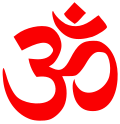 | |
 | |
| Total population | |
|---|---|
| c. 1.17 billion (60.9% of the total South Asian population) [a] | |
| Regions with significant populations | |
| | 1,124,484,380 (2024) [1] [b] [8] [9] [10] [11] |
| | 25,271,378 (2024) [2] [c] [12] |
| | 13,495,775 (2024) [3] [d] [13] [3] [14] [15] |
| | 5,476,289 (2024) [4] [e] [17] [18] [19] |
| | 2,769,809 (2024) [5] [f] [20] [21] |
| | 195,485 (2024) [6] [g] |
| | 50 (2021) [22] |
| Religions | |
| Hinduism Tribal religions (including Sarnaism, Nanakpanthi, Kalasha and others) (minority) | |
| Scriptures | |
| Bhagavad Gita and Vedas also see other Hindu texts | |
| Languages | |
| Predominant spoken language Hindi Recognized regional languages Sacred language Sanskrit (Sacred) [23] | |
Hinduism is the largest religion in South Asia with about 1.2 billion Hindus, forming just under two-thirds of South Asia's population. [a] [b] [c] [e] [f] [g] [24] South Asia has the largest population of Hindus in the world, with about 99% of all global Hindus being from South Asia. [25] Hinduism is the dominant religion in India and Nepal and is the second-largest religion in Bangladesh, Pakistan, Sri Lanka, and Bhutan. [26]
Contents
- History
- Origins
- Rise of Hindu Nationalism
- Temples
- Organisations
- Political
- Social
- Demographics
- See also
- Notes
- References
- Citations
- Sources
- External links
Indo-Aryan migrations brought the Indo-Aryans to South Asia, [27] where they compiled and composed the Vedic corpus during the Vedic period (ca. 1500-500 BCE) across present-day Northern India, Pakistan and Afghanistan. [28] The subsequent period, between 800 BCE and 250 BCE, was "a turning point between the Vedic religion and Hindu religions", and a formative period for Hinduism, Jainism and Buddhism. The Epic and Early Puranic period, from c. 250 BCE and 500 CE, saw the onset of the Hindu synthesis, followed by the classical "Golden Age" of India (c. 350 - 650 CE), which coincides with the Gupta Empire. [29]
Following the conquest of Islamic rulers in the Indian subcontinent and spread of Islam in South Asia, an era featuring persecution of Hindus began and continued until the end of Mughal Empire. [A] The Vijayanagara and Maratha Empire significantly protected and revived Hinduism in the Indian subcontinent, while the Jaffna Kingdom and Gorkha dynasty have significantly protected Hinduism in Sri Lanka and Nepal respectively. [29]







